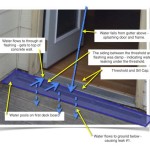```html
How to Fix a Flooded Basement: A Comprehensive Guide
A flooded basement can be a homeowner's worst nightmare. Beyond the immediate inconvenience and mess, it can lead to significant structural damage, mold growth, and health hazards. Addressing the problem promptly and effectively is crucial to mitigating these risks. This article provides a comprehensive guide on how to fix a flooded basement, covering everything from initial safety precautions to long-term prevention strategies.
Safety First: Prioritizing Your Well-being
Before entering a flooded basement, prioritizing safety is paramount. Water conducts electricity, creating a potentially lethal environment. The first step is to identify and eliminate the source of the flooding, if possible. If the source is a burst pipe or a malfunctioning appliance, immediately shut off the main water supply to the house. Next, and most importantly, disconnect the power. This can be achieved by turning off the main circuit breaker for the entire house. Do not attempt to reach the breaker box if you are standing in water. Contact an electrician immediately if you cannot safely access the breaker box.
Standing water can also be contaminated with sewage, chemicals, or other hazardous materials. Wear appropriate protective gear, including waterproof boots, gloves, and eye protection. A respirator or mask is recommended if there is a strong odor or visible mold. Avoid contact with the water as much as possible. If you suspect sewage contamination, contact a professional cleaning service specializing in hazardous waste removal.
Once the immediate safety concerns are addressed, assess the structural integrity of the basement. Look for cracks in the foundation, water damage to support beams, or any other signs of instability. If you notice any significant structural damage, do not attempt to enter the basement until it has been inspected by a qualified structural engineer.
The Immediate Response: Removing the Water
With safety precautions in place, the next step is to remove the water from the basement. The method used will depend on the amount of water and the accessibility of the space. For minor flooding (a few inches), a wet/dry vacuum can be used. Ensure the vacuum is designed for water removal and follow the manufacturer's instructions carefully.
For more significant flooding, a sump pump is the most effective solution. A sump pump is a submersible pump designed to remove water from basements. If you have a permanent sump pump installed, ensure it is functioning correctly. If not, you may need to purchase or rent a portable sump pump. Position the pump in the lowest area of the basement and connect a discharge hose to direct the water away from the foundation. The hose should be long enough to reach a drainage area that is at least 20 feet away from the house.
Consider the impact the discharged water has on your landscape and your neighbors. Avoid directing the water towards neighboring properties or areas prone to erosion. It may be necessary to use multiple pumps or to work in stages to gradually remove the water without overwhelming the drainage system.
As the water is being removed, document the damage. Take photographs and videos of the flooded areas, damaged belongings, and any structural issues. This documentation will be essential when filing insurance claims.
Drying and Dehumidifying: Preventing Mold Growth
Once the water has been removed, the next crucial step is to thoroughly dry and dehumidify the basement. Mold growth can begin within 24-48 hours in a damp environment, so acting quickly is essential.
Open windows and doors to allow for natural ventilation, if weather permits. Position fans to circulate air throughout the basement, focusing on damp areas. Industrial-strength fans are more effective than household fans for drying large areas. Consider renting these from a local tool rental store.
Use dehumidifiers to remove moisture from the air. Dehumidifiers draw in damp air, extract the moisture, and release dry air. Choose a dehumidifier with sufficient capacity for the size of your basement. Empty the water collection tank regularly, or connect the dehumidifier to a drain hose for continuous operation.
Remove any wet or damaged materials, such as carpeting, drywall, insulation, and furniture. These materials are breeding grounds for mold and should be discarded promptly. If you are unsure whether an item can be salvaged, consult with a professional restoration company.
Clean and disinfect all surfaces that have been in contact with floodwater. Use a solution of bleach and water (approximately 1 cup of bleach per gallon of water) to kill bacteria and mold spores. Wear gloves and eye protection when using bleach. Ensure surfaces are thoroughly rinsed and dried after disinfection.
Addressing Structural Damage: Foundation Repairs
A flooded basement can exacerbate existing structural problems or create new ones. Examine the foundation walls for cracks, leaks, or signs of water damage. Small cracks can often be repaired with epoxy or hydraulic cement. Larger cracks or structural issues may require professional repair.
Water pressure can cause foundation walls to bow or buckle. If you notice any signs of inward movement, consult with a structural engineer immediately. They can assess the damage and recommend appropriate repair methods, such as installing carbon fiber straps or reinforcing the foundation walls with steel beams.
Check the basement floor for cracks or unevenness. Water can seep through cracks in the floor, causing further damage. Patch any cracks with concrete patching compound. If the floor is significantly damaged, it may need to be replaced.
Inspect the window wells for proper drainage. Window wells that are clogged with debris can allow water to accumulate and seep into the basement. Clean out the window wells regularly and ensure they have adequate drainage.
Preventing Future Flooding: Long-Term Solutions
Preventing future flooding is crucial to protecting your home and property. Several strategies can be implemented to minimize the risk of basement flooding.
Improving Drainage: Proper drainage is essential for diverting water away from the foundation. Ensure your gutters are clean and free of debris. Downspouts should extend at least 10 feet away from the foundation and direct water towards a drainage area. Consider installing French drains or surface drains to collect and redirect rainwater away from the house.
Landscaping: The grade of your property should slope away from the foundation. If the ground slopes towards the house, water can accumulate around the foundation and seep into the basement. Regrade the soil around your house to create a positive slope away from the foundation.
Sump Pump Maintenance: If you have a sump pump, inspect it regularly to ensure it is functioning correctly. Test the pump by pouring water into the sump pit and observing whether it activates automatically. Clean the sump pit and remove any debris that could clog the pump. Consider installing a battery backup for the sump pump in case of power outages. A secondary, higher-capacity pump can also be considered in areas with high water tables or a history of flooding.
Sealing Foundation Walls: Applying a waterproof coating to the exterior of the foundation walls can help prevent water from seeping through the concrete. This is especially important for older homes with porous foundations. Consult with a professional waterproofing contractor to determine the best type of coating for your specific situation.
Installing a Backflow Preventer: A backflow preventer is a device that prevents sewage from flowing back into your home through the plumbing system. This is particularly important if your home is located in an area with a history of sewer backups. Consult with a plumber to determine if a backflow preventer is necessary for your home.
Regular Inspection: Routinely inspect your basement for signs of water damage or leaks. Early detection can prevent minor problems from escalating into major flooding events. Pay attention to unusual odors, damp spots on walls or floors, and any changes in the appearance of the foundation.
```
How To Repair A Flooded Basement Acculevel

Flooded Basement Cleanup Who To Hire And Steps Take Bob Vila

8 Smart Tips For Fixing Flooded Basements Basement Water Damage Repair

How To Clean A Flooded Basement Reviews By Wirecutter

6 Simple Ways To Prevent Basement Flooding American Dry

How To Clean A Flooded Basement News And Events For Systems Inc

Water In Your Basement What To Do And Who Call Forbes Home

What Causes Basement Flooding

Why Is Your Basement Leaking How Hydrostatic Pressure Leads To Flooding

Flooded Basement How To Clean Up
Related Posts







